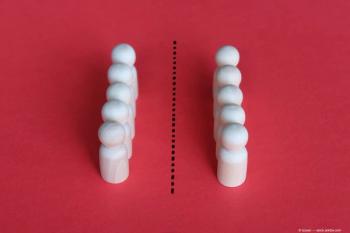
Patient Case #1 Impressions and Treatment Takeaways
Blake K Williamson MD, MPH, MS, evaluates surgical correction options for a patient with low myopia and astigmatism and describes how phakic intraocular lens (IOL) implant can be a preferable option even in low myopia.
Blake K. Williamson, MD, MPH, MS: My initial impression of this case is that this a patient who’s in their mid-30s, who is myopic and wants better distance vision. This is something that routinely could be performed with laser vision correction on the cornea, but there were some challenges because of the thickness of the corneal pachymetry. Classically, when taking care of patients with laser vision correction on the cornea, anytime corneal pachymetry is less than 500 μm, that’s a red flag where you want to look very closely at what’s going on, especially in the case of someone who hasn’t had prior corneal refractive surgery like in this case. This was a virgin cornea that had never had prior surgery. So it’s a red flag, and it’s quite abnormal to have a pachymetry in the mid-400 μm range or even lower, like was seen in this case. As a result of that, you start to think about other options. We could have thought about a custom lens replacement in this patient, or a refractive lens exchange, as some people call it. But again, in a young patient with myopia, it may be a bit aggressive, especially if there’s something that is perhaps safer, less invasive, and reversible.
Then you start to think about phakic IOLs [intraocular lenses], and the ICL [implantable contact lens] is something I’ve had a lot of success with. What’s interesting about this case is this patient, if you remember, is only about a -3 to a -2.75 [myopia measure]. That’s classically not what you think about being in the ICL realm. We’ve thought about for years ICL being reserved for patients who couldn’t otherwise have LASIK or PRK [photorefractive keratectomy], those patients with abnormally large myopia powers of -9, -10, -11, -12, -13, on up. This case [has] quite low myopia, at least with regard to a patient getting ICL, yet it can be wonderful in that setting because we know that the new ICL goes all the way down to about -3.
There are different parameters you need to be looking at anatomically when planning your surgical correction. For astigmatism, I think it’s important that you have multiple devices agreeing in terms of the magnitude and the meridian of astigmatism. It’s very important for you to have a correct pachymetry map, and very important for you to be looking at elevation maps. We know that you have to have some posterior elevation for you to have keratoconus, that’s one of the most important things. If you don’t have an elevation map, I don’t know that it’s best in class in terms of offering vision correction, especially corneal vision correction specifically.
There are also other parameters out there with regard to epithelial mapping. I think that’s the next frontier, to pick up subtle signs of ectasia, and perhaps be even more sensitive to ruling out those patients who probably shouldn’t have a corneal-based procedure.
Some of the risks associated with LASIK and PRK are well known. LASIK is perhaps one of the safest and most successful surgical procedures that medical science has ever given mankind, yet there’s no such thing as a perfect procedure. LASIK is close, but there is no such thing as a perfect procedure. Anytime we’re doing LASIK we always discuss the risk of things like DLK, diffuse lamellar keratitis, that’s super important. The risk of flap striae can happen if patients are rubbing their eyes or not wearing their goggles appropriately. Some patients do have a transient foreign body sensation, or dry eye disease, which typically is well treated and usually dissipates rapidly once the corneal nerves regrow and the patient can be tapered down on their artificial tears. PRK has a lot of those things also. The concern of haze is there for PRK as well, but that has gone down drastically since the use of mitomycin C.
Who do I recommend this to? I recommend this to patients who typically I think would do very well with the optics, perhaps that patient who has a thinner cornea, such as this case. But also perhaps patients who may have a preexisting dry eye disease. You can avoid the cornea entirely. Also, some of those patients whose corneal topography and tomography may lead you to believe that they don’t have a totally normal cornea. Maybe they have some inferior steepening or just some very mild elevation, but no other signs of keratoconus. Anytime I’m iffy at all with not wanting to touch the cornea, ICL is something I feel very confident and safe using. [Patients’] experience afterward is fantastic. I think there’s less pain associated with it in the immediate postoperative period. They get faster visual recovery than laser vision correction on the cornea. And patients are extremely happy, as was the case here.
What stood out to me in the roundtable discussion I had with my colleagues is that, the point was made that you typically aren’t even thinking about ICL in patients who are -3, yet If you didn’t offer ICL, as a refractive surgeon you would have no other great option for this patient. You’d have to tell this patient, “There’s nothing I can do for you.” Even though we know that ICL works beautifully, as it did in this case, he did fantastic and was very happy. It’s life-changing, really. So, if you’re going to be a comprehensive refractive surgeon, I think what we learned from this case is that you’ve got to be very comfortable with ICL, even in lower levels of myopia and astigmatism that you might not classically consider for phakic IOL.
Transcript edited for clarity
Newsletter
Don’t miss out—get Ophthalmology Times updates on the latest clinical advancements and expert interviews, straight to your inbox.

















































.png)


